
Summary
TrueNASs open-source flexibility adapts to any storage needs, large or small.
Rising Interest in DIY NAS Systems for Personal Data Management
As technology enthusiasts increasingly turn to homelabs for experimentation and skill development, the DIY Network Attached Storage (NAS) has emerged as a pivotal element in personal server environments. This article examines the motivations behind setting up a DIY NAS, evaluates the hardware and software considerations involved, and explores effective management strategies. “A DIY NAS offers a unique opportunity to gain hands-on experience in managing data solutions while retaining full control over privacy and customisation,” remarks Alex Turner, an industry observer.
Main Article
The concept of a homelab, a personal server space for testing and deploying various software, has gained traction among tech aficionados and professionals seeking to enhance their skills. Central to many homelabs is the DIY NAS, a cost-effective data management and storage solution that offers customisation beyond what commercial products provide.
Motivations for Building a DIY NAS
The appeal of a DIY NAS lies in its multifaceted benefits. It serves as a fertile ground for skill development in system administration, networking, and data management. By utilising existing hardware and open-source software, individuals can build a tailored storage solution that aligns with specific needs. Furthermore, the ability to customise hardware and software configurations fosters an environment of control and privacy, addressing challenges such as automating backups or hosting media libraries. “The beauty of a DIY NAS is the flexibility it offers, allowing users to address precise personal or professional challenges,” notes Lisa Graham, an industry analyst.
Selecting Appropriate Hardware
Choosing the right hardware is crucial for a successful NAS setup. The decision-making process must consider the intended workload and purpose of the NAS, whether as a file server, media centre, or a platform for virtualisation and containerisation. Performance requirements vary; for instance, media streaming demands higher CPU capabilities, while data backups emphasise storage capacity.
Considerations extend to form factor and power consumption, balancing space constraints with energy efficiency. Options range from compact single-board computers to more robust custom builds. Budgetary constraints also play a significant role, necessitating a balance between initial expenditure and ongoing operational costs. “Understanding your specific needs and constraints is key to selecting the right hardware components,” suggests Michael Roberts, a technology commentator.
Exploring Software Ecosystem
The NAS software landscape is diverse, catering to various expertise levels and requirements. TrueNAS, renowned for its robust ZFS support, appeals to users seeking enterprise-grade features. OpenMediaVault (OMV), with its user-friendly interface, is ideal for newcomers. UnRAID, known for its unique storage and virtualisation capabilities, provides flexibility, albeit at a price. For those inclined towards creating a personal cloud, Nextcloud offers an extensive suite of file-sharing and collaboration tools.
Implementation Steps
Once hardware and software decisions are made, the installation process begins. Users should install the chosen NAS operating system using a bootable USB drive, configuring system settings according to their needs. Storage configuration is critical, with options for RAID arrays enhancing redundancy and performance. Network configuration follows, ensuring seamless connectivity through IP address setups and necessary network services.
Security measures, including strong passwords and firewall configurations, are paramount to safeguarding the NAS against vulnerabilities. The deployment of additional services, such as backup solutions or media servers, further customises the NAS to meet specific user requirements.
Ongoing Management and Maintenance
The longevity and reliability of a NAS depend on effective management and maintenance strategies. Regular backups, both on-site and off-site, are essential to protect against data loss. Monitoring tools facilitate system performance tracking and alert users to critical events like hardware failures or security breaches.
Keeping NAS software and applications updated is vital for maintaining security and stability. Energy efficiency should not be overlooked, with optimised power settings and energy-efficient hardware reducing operational costs. “Consistent maintenance ensures that your NAS remains a reliable component of your homelab, delivering value over the long term,” advises Sarah Collins, a technology expert.
Detailed Analysis
The increasing popularity of homelabs and DIY NAS setups reflects broader trends in the tech industry, where personalisation and control over data have become paramount. As data privacy concerns grow and cloud storage solutions face scrutiny over security, individuals are drawn to self-hosted solutions that offer greater autonomy. The DIY NAS aligns with the DIY ethos prevalent in tech circles, fostering innovation and skill development. This trend is further bolstered by the proliferation of accessible open-source software and affordable hardware options, making it feasible for enthusiasts to engage in sophisticated data management projects.
Further Development
As the landscape of personal data management continues to evolve, DIY NAS setups are likely to gain further traction. Future developments may focus on enhanced security features, integration with emerging technologies such as artificial intelligence, and advancements in energy-efficient hardware. Readers are encouraged to stay tuned for additional insights and updates on the DIY NAS phenomenon, as the intersection of technology and personalisation continues to shape the future of data management.

